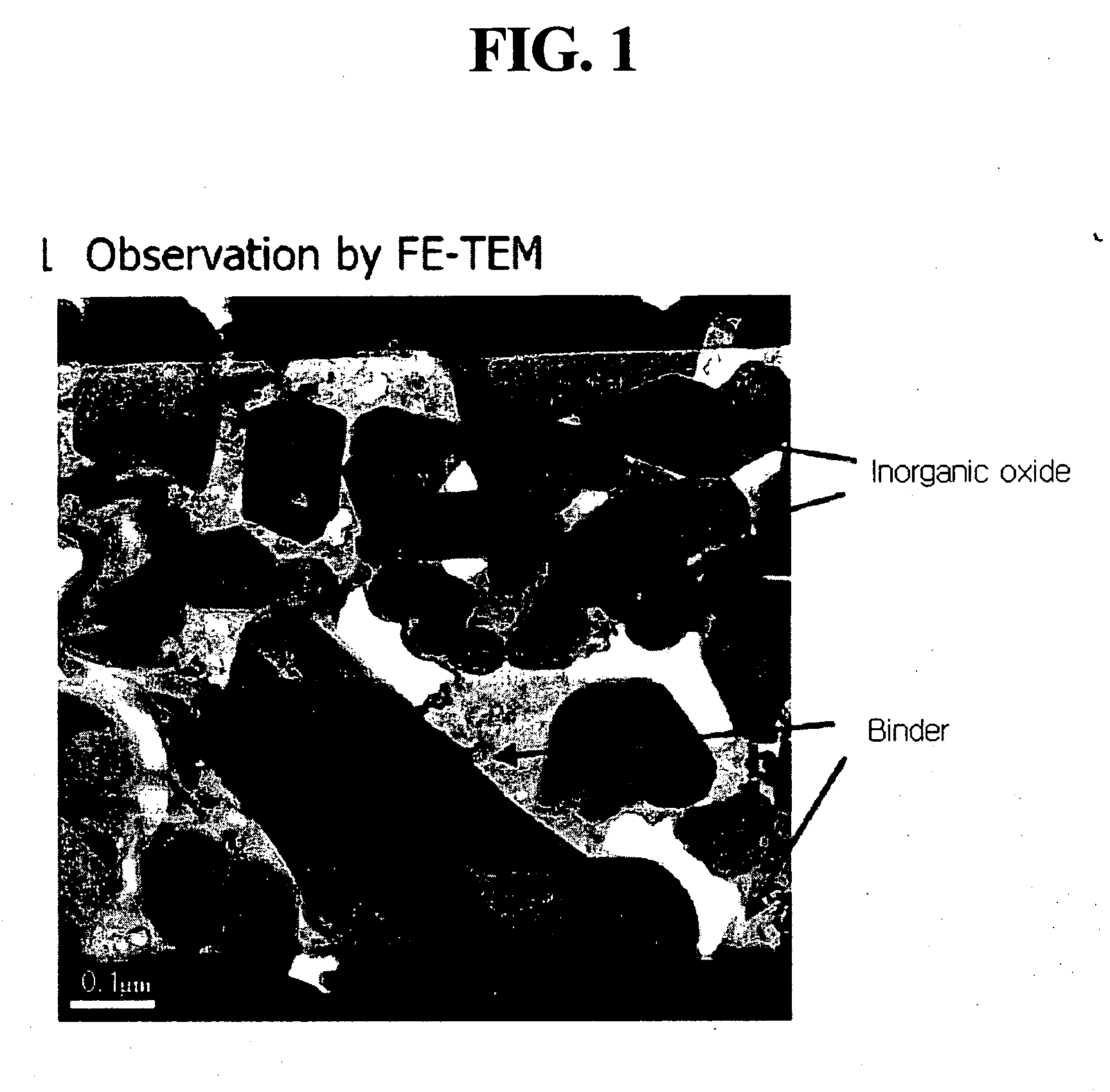Lithium rechargeable battery
- Summary
- Abstract
- Description
- Claims
- Application Information
AI Technical Summary
Benefits of technology
Problems solved by technology
Method used
Image
Examples
experimental example 1
Test of Winding Characteristics
[0084] The elongation ratio of a binder is determined by measuring how the binder can extend without causing snap-off on the basis of the initial length of the binder, when the binder is drawn after the polymerization thereof That is, elongation ratio=(Δl / l0)*100%, wherein Δl means elongation length and l0 means the initial length.
[0085] Each of the anodes having a porous membrane, obtained according to Comparative Examples 1 to 3 and Examples 1 to 5, was wound into a jelly-roll shape.
TABLE 1elongation ratiocondition of electrodeof binderplatewindingComp. Ex. 1125%crackingnot availableComp. Ex. 2150%crackingnot availableComp. Ex. 3175%crackingnot availableEx. 1200%no crackingavailableEx. 2225%no crackingavailableEx. 3250%no crackingavailableEx. 4275%no crackingavailableEx. 5300%no crackingavailable
[0086] As can be seen from Table 1, an elongation ratio ranging from 200% to 300% allows winding of an anode. If a binder has an elongation ratio less th...
experimental example 2
Test of Flexibility
[0089] Each of the electrode plates according to Comparative Examples 4 to 9 and Examples 6 to 9 was wound around a cylindrical bar having a diameter ranging from 1 mmF to 5 mmF with an interval of 0.5 mm, and was determined whether any cracking occurred or not by using a microscope. Herein, as the diameter of a cylindrical bar, which causes cracking, decreases, the electrode plate has higher flexibility.
TABLE 2type of binder (3 wt %)winding testComp. Ex. 4PVDF (Polyvinylidene fluoride)cracking @ 4.5 mmFComp. Ex. 5SBR (Styrene-butadiene rubber)cracking @ 4.0 mmFComp. Ex. 6Methoxymethylacrylatecracking @ 3.0 mmFComp. Ex. 7Metoxyethylacrylatecracking @ 3.5 mmFComp. Ex. 8Etoxyethylacrylatecracking @ 3.0 mmFComp. Ex. 9Butoxyethylacrylatecracking @ 3.5 mmFEx. 6Polymer blend of Acrylonitrile +cracking @ 1.5 mmFMetoxymethylacrylateEx. 7Polymer blend of Acrylonitrile +cracking @ 1.5 mmFMetoxyethylacrylateEx. 8Polymer blend of Acrylonitrile +cracking @ 2.5 mmFEtoxyethyl...
examples 10 to 15
[0094] Comparative Example 10 was repeated, except that a fist heat treating step was performed via IR drying at 100 to 120° C. for 5 hours and a second heat treating step was further carried out via vacuum drying at 150 to 200° C. for 5 hours, as shown in Table 3.
PUM
 Login to View More
Login to View More Abstract
Description
Claims
Application Information
 Login to View More
Login to View More - Generate Ideas
- Intellectual Property
- Life Sciences
- Materials
- Tech Scout
- Unparalleled Data Quality
- Higher Quality Content
- 60% Fewer Hallucinations
Browse by: Latest US Patents, China's latest patents, Technical Efficacy Thesaurus, Application Domain, Technology Topic, Popular Technical Reports.
© 2025 PatSnap. All rights reserved.Legal|Privacy policy|Modern Slavery Act Transparency Statement|Sitemap|About US| Contact US: help@patsnap.com


